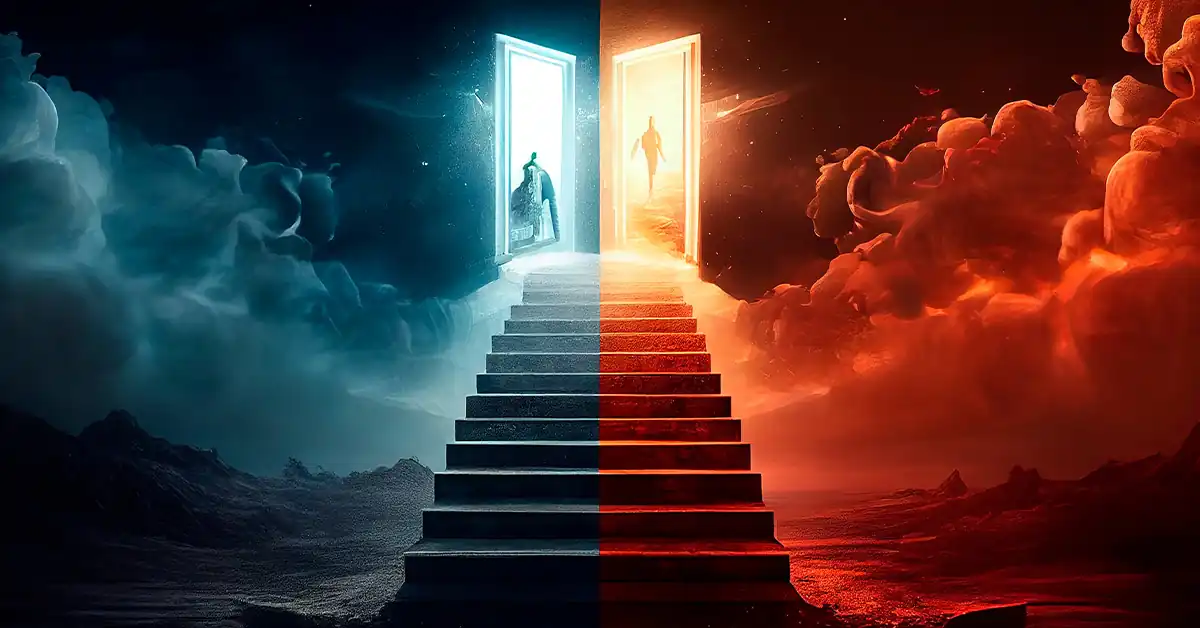The Afterlife Confusion!

What Happens in the Afterlife Before Judgment?
This is the question almost everyone thinks they’ve already answered, yet almost nobody agrees on.
The afterlife before final judgment is one of the most fractured and foggy topics in Christian theology. And it’s not just between Catholics, Orthodox, and Protestants. The disagreement within Protestantism itself is staggering.
What is Hades? What is Hell? Is there consciousness between death and resurrection? Is torment happening now, or later? Or never? You’d think the church that claims to be full of the Spirit and grounded in Scripture would have a unified answer. But that couldn’t be further from reality.
In fact, the one “proof text” everyone clings to is a single parable, the rich man and Lazarus, ripped from its literary and historical context, then twisted to fit whatever doctrine each group already believes.
And that’s the shaky ground on which entire theologies of eternal torment or annihilation are built.
The Problem: Everyone Claims Certainty, Yet All Disagree
Here’s the irony: All of these people claim to be “led by the Spirit,” “filled with truth,” and “grounded in Scripture.” And yet their views on what happens after death, before final judgment, are wildly incompatible.
They all preach as if they’re 100% right. But they can’t all be.
So who actually knows the truth?
When you examine the full landscape, it becomes painfully clear: nobody really knows, and nearly every denomination is guessing, projecting, or defending a handed-down tradition they never questioned.
Protestant Confusion on Full Display
Let’s look at the Protestant world, supposedly the “sola scriptura” champions, and see just how chaotic it really is.
A Side-by-Side Comparison: Protestant Views on Hades and Hell
| Denomination / Group | View of Hades / Sheol (Now) | View of Hell (After Judgment) | Conscious Between Death & Resurrection? |
|---|---|---|---|
| Southern Baptists | Conscious torment until judgment | Eternal conscious torment | Yes |
| United Methodists | Conscious but vague, open to mystery | Generally eternal torment, but not dogmatic | Yes |
| Lutherans (Missouri Synod) | Conscious intermediate state | Eternal separation (often viewed as torment) | Yes |
| Presbyterians (PCA) | Conscious state, God’s presence felt as wrath | Eternal conscious punishment | Yes |
| Assemblies of God | Immediate conscious torment or peace | Eternal conscious punishment | Yes |
| Seventh-day Adventists | Soul sleep, unconscious | Final annihilation | No |
| Church of God (Anderson) | Dead sleep until resurrection | Final destruction (not torment) | No |
| Christadelphians | No immortal soul, unconscious | Dead stay dead after judgment | No |
| Pentecostal Holiness Church | Conscious torment for wicked | Eternal conscious torment | Yes |
| Free Will Baptists | Conscious intermediate state | Eternal conscious torment | Yes |
| Non-denominational Evangelicals | Most follow eternal torment view | Eternal conscious torment | Yes |
They All Call Themselves “Spirit-Filled” Yet Can’t Agree on the Basics
How can every one of these denominations claim to be led by the same Holy Spirit, yet preach completely opposite views of something so central?
Either the Spirit is confused, or they are.
They all open the same Bible.
They all use the same verses.
They all appeal to the same parable.
And they all act as if their view is the definitive, divinely-revealed truth.
Yet the very fact that you could be in two churches on the same street corner and hear two totally opposite explanations of what happens the moment you die shows just how fragile and artificial these systems are.
The Root of the Chaos: One Parable, Wrongly Elevated
Nearly all of these doctrinal systems, especially the ones supporting eternal conscious torment (ECT), rely heavily, if not solely, on the parable of the rich man and Lazarus (Luke 16).
But Jesus never said this was a literal description of the afterlife. In fact, the story borrows imagery from popular first-century Jewish folklore, not the Torah. The language is symbolic, didactic, and aimed at exposing hypocrisy, not revealing metaphysics.
Yet people cling to it like it’s a news report from the underworld.
The absurdity of this becomes apparent when you realize:
- The parable mentions Abraham’s bosom, something found nowhere else in Scripture.
- The rich man is somehow speaking across a chasm, yet still thirsty.
- There’s no mention of the cross, no gospel, no judgment seat.
And yet from this one dramatic story, entire eschatologies are crafted, while dozens of plain Scriptures are ignored or reinterpreted to support the myth.
Eternal Torment and Annihilation: Both Miss the Point
Both the ECT and annihilationist models suffer from the same fatal flaw: they assume death is final. They assume God is done with you once you die, either to burn you forever, or erase you entirely.
But that kind of thinking is built on fear, not truth. It’s built on legalistic frameworks and pagan imports, not on the character of God revealed in Christ.
Scripture says, “God is love.”
It says His mercy endures forever.
It says Jesus is the Savior of all, especially those who believe.
Yet traditional theology takes these truths and stuffs them into a Roman torture chamber, then calls it justice.
The annihilationist tries to soften it, but the outcome is still the same: God gives up. He doesn’t rescue. He doesn’t restore. He doesn’t reconcile. He simply destroys what He once called “very good.”
The Beauty of Universal Reconciliation
In contrast to the confusion, fear, and contradiction of ECT and annihilation, Universal Reconciliation stands as the only view that refuses to compromise either the justice or the love of God.
It holds that:
- Death is not the end.
- Judgment is not rejection, but restoration.
- Hades is a realm of correction, not finality.
- Fire is purifying, not punishing.
- Torment is real, but redemptive.
Universal Reconciliation doesn’t need to twist one parable into an eternal doctrine. It reads the whole story. It sees that every knee will bow, not in forced submission, but in heartfelt awe.
That all things will be reconciled to God through Christ (Colossians 1:20).
That God will be all in all (1 Corinthians 15:28).
That mercy triumphs over judgment (James 2:13).
So, What Happens After We Die?
Let’s tell the truth: We don’t know everything.
We’re not supposed to build dogma on fog.
We’re not supposed to slap fire and brimstone over the unknown and call it faith.
But here’s what we do know:
- The Church is fractured, not united, on the subject.
- Every denomination claims certainty, but contradicts the others.
- The entire doctrine of torment rests on a single parable, interpreted as if Jesus were giving a guided tour of the underworld.
- The systems built on these interpretations contradict the character of Christ and the revealed heart of God.
If you’ve been bound in fear, terrified of death, of flames, of torture, of annihilation, know this:
Those doctrines aren’t Gospel. They’re not good news.
They’re just the echoes of confusion, built on mistranslation and centuries of religious control.
The truth is better. The fire is real, but it heals. The judgment is real, but it restores. And the God who is love never fails.
- 09/03/2025
- WRITE A COMMENT
Recent Posts
- The Eternal False Translation: How Aionios Was Corrupted Into Eternal
- The Rich Man and Lazarus
- Does Grace Last Forever?
- His Love Never Fails
- Love and Forgive Your Enemies
- His Mercy Endures Forever
- Scriptures That Teach Universal Reconciliation
- The Lesson of James, Peter and John
- Progressive Salvation is Biblical!
- The Gates Never Shut!


